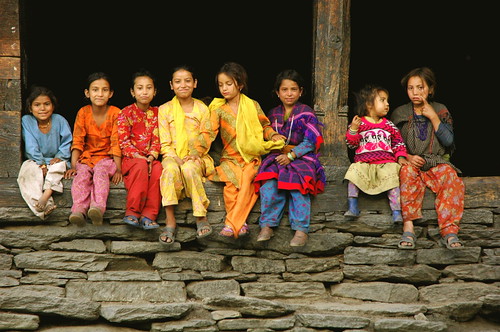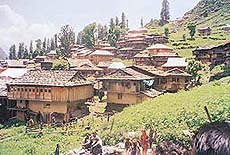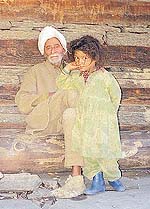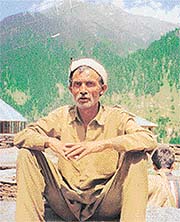| |
MALANA...A 2000 YEAR OLD VILLAGE IN HIMALAYS...WHO ARE THESE MALANIS????
Posted by Vishva News Reporter on August 9, 2009 |

Malana Village, in Himachal Pradesh, India is a 2000 year old remote community of 200
families with an unique political system is located at an altitude of
10,000 ft. Over the centuries, the isolation of Malana helped to preserve
its unique socio-cultural practices.
For many years after independence Malana continued to exist as a state
within a state, as the rules of Indian government were simply not
accepted by the people. The village has been a curious subject of study
by researchers and documentary filmmakers.
The village’s crude democratic practices has often been claimed to be a
lifestyle of old community living, no more existent in modern times.
The villagers even trace their lineage to the Greek armies of Alexander
the Great, who were left behind after his invasions of north India in
326 B.C.
Faced with continued hostility and in order to protect their culture,
ancestors of Malana are said to have retreated into this inaccessible
valley across the Chanderkhani pass in Kullu valley.
Besides researchers, the village attracts hordes of foreigners. ‘Malana
cream’ the brand dope processed by the villagers is considered to be one
of the finest marijuana available anywhere in the world. Sources claim
that it is also one of the highest priced dope in the international
market. In recent years, government agencies have tried to dissuade the people
from growing, processing and trading in the contraband, but have failed
to eradicate marijuana farming.
|
Malanis have sharp features and look like
Europeans.....
|
|
 
LEFT PHOTO:
Young Malana woman producing hashish resin from cannabis plant (2006)
RIGHT PHOTO: Women mourn the loss after the devastating fire in Malana on
Saturday, Jan 5, 2008.Over 150 houses gutted in oldest surviving
democracy of the world Malana Barrage (Kullu). Over 150 houses and six
temples and ‘bhandars’ (temple stores) of Jamlu Devta, the presiding
deity of the famous Malana village, were destroyed in a fire that broke
out around 7.45 am. The village is known as the oldest surviving
democracy of the world. Villagers tried melting snow to douse fire — Photo by Subhash Sharma-
The Tribune, Sunday, January 6, 2008, Chandigarh, India |

In Malana, a 2000-yr old
village tucked in the Himalayas, there are children everywhere you look.
|
PVAF in its continuing endeavour to spread knowledge about who we
are and where we are among the human and creation diversity, today
publishes this news story of the 2000 year old community of Malana in
northern state of Himachal Pradesh, India located in Himalayas at an
altitude of 10,000 ft.....A road being built in a remote part of the Himalayas is putting
team of anthropologists researchers on course to study a village populated by descendants of
Alexander the Great’s army.
According to local legend, the fair-haired and blue-eyed inhabitants of
Malana are descended from Alexander’s soldiers, who settled down
after tiring of conquest.....
Please click on the next line to read more about this news....plus more
photos about Malana and its residents and a couple of takes from web
search on what is known about Malana and its fascinating history..... |
LIFE IN MALANA
VILLAGE...PHOTOS WORTH THOUSAND WORDS....
|
Musicians play hypnotic rythms
on Malana's most sacred holiday. The village people are deeply
superstitious and God-fearing

Village Temple
|
|

LEFT PHOTO: Men relax during a
spiritual holiday in Malana. The village people are deeply superstitious
and God-fearing.
 
Residents of Malana Village
may be the descendants of Alexander the Great's army.
|
Alexander the Great and the blonds of the Himalayas..
Anthropologists probe legend that
remote Indian village of malana
is
populated by
descendants of Alexander’s army
From:
Edmonton Journal:
8 August 2009: Dean Nelson
|
A road being built in a remote part of the Himalayas is putting
researchers on course to study a village populated by descendants of
Alexander the Great’s army.
According to local legend, the fairhaired and blue-eyed inhabitants of
Malana, India, are descended from Alexander’s soldiers, who settled down
after tiring of conquest.
A team of anthropologists has set out to unravel a mystery that has
fascinated historians for centuries. Scientists from Sweden and India
have joined forces to establish the origins of the unique culture and
language.
Malana has attracted hippies since the Sixties, lured by its prized
cannabis.
The village also boasts what is believed to be the oldest experiment in
democracy.
Its people operate their own republic, with an elected upper and lower
house. The village has a judicial system with a high court to resolve
disputes among the 200 families. All outsiders are regarded as
untouchable and visitors are fined about $20 Cdn if they brush against
them or their homes.
Academics believe their system, unique in India, may have its origins in
ancient Greece, imported into Malana by Alexander’s army.
According to the legend, Alexander stopped in Malana, part of Himachal
Pradesh, in 326 BC when he defeated King Porus of what is now Punjab.
However, the battle sapped his army’s confidence and some decided to
settle with local women.
|
Professor P.K. Vaid, of the Institute of Tribal Studies, Shimla, said
his study would solve the mystery by DNA testing to determine any links
to people in Macedonia and the Aegean region.
“Their features appear to be European,” he said. “They have blue eyes
and fair hair.
“ Their democratic system could have its roots in Greece. It’s unique.”
The suggestion that Malana’s villagers could boast an illustrious
heritage drew a skeptical reaction.
Ridhu Ram, the chief priest, said Alexander’s army never reached Malana,
but was repelled when it reached the mountain that overlooks it.
“Our goddess hit them with heavy bullets and they all died,” he said.
Along with a faith in the power of gods, like the ancient Greeks, they
defer to oracles.
Ram, 60, said Malani law set down unique penalties. Rapists were forced
to marry their victims, or feed and clothe them for a year if the victim
did not wish to be their wife.
Those who “stole” another man’s wife had to pay him about $1,000 Cdn in
compensation, but if the woman in turn left him for another, he would
receive double the amount he paid. “I stole another man’s wife 20 years
ago and had to pay a fine of 15 rupees,” Ram said.
The priest said most Malanis did not care about their origins but were
concerned that the isolation that had preserved their traditions was
under increasing threat from the road to the new hydroelectric power
station.
“We have our laws, we have freedom and we are satisfied with that,” he
said.
|

The tribal village of Malana,
which has its own system of governance, is fortified by natural barriers
THE tribal village of Malana in Kulu district of Himachal Pradesh is
sometimes called ‘the Republic of Malana’ because the Malanis have their
own system of governance. Besides a legislature and an executive body,
the ‘Republic of Malana’ also has a judiciary. Although property and
social disputes are very rare among the Malanis, if there is any such
dispute it is taken to the judicial council — the Malana Supreme Court —
for the final judgement and not to any government agency or court of
law. The Malana court then fixes a day for its verdict as per the norms
of the oral constitution of the Malana ‘state’. The oral constitution
inherited from ancestors and passed on to generations states that on the
appointed day both parties involved in the dispute — plaintiff as well
as the defendant or any representative from their families — must take
bath under a nearby waterfall early in the morning without being seen by
anybody. Without eating or drinking anything and draping a white blanket
robe around the body, they should come to attend the court proceedings,
watched by all members of the ‘upper house’ and, if possible, by all
villagers.

The head priest of Malana with
a village girl
In accordance with the constitution, two white lambs of equal weight and
age are selected by court officials from the village without paying any
prize to the owners and brought to the devta’s place — the venue of the
court proceedings. In full view of the court and the public, the court
proceedings start by preparing two equal doses of jaihar mohra — a
herbal poison which is locally available. On the right foreleg of each
lamb, a three-inch long and about one-and-a-half-inch deep incision is
made with a sharp knife. The poison is then put inside the cut (of both
the lambs), which is then sown together with a needle and thread. Both
the lambs are then taken to the devta’s place (an enclosure) and tied to
temporarily erected posts by the court officials. The judicial members
of the council allot each lamb to each party in dispute. Escorted by the
court officials, the plaintiff and the defendant are then brought to the
venue and asked to kneel down in front of their allotted and poisoned
lambs. Then begins the wait for the lamb that dies first. When either of
the lambs appears to be dead, the warrant officer confirms its death by
putting dust into its eyes. When the death of any one of the lambs is
thus confirmed, the warrant officer announces it to the court. The party
whose lamb dies first in the proceedings is declared to have lost the
case. The lamb that dies later wins the case for its party. The winning
party is then required to give a feast to the whole village. No money,
no delay, no advocates, no long wait but the lives of two innocent lambs
sacrificed to passed the last judgment!
The Malana tribe is unique in many other respects too. Malanis have
chosen a non-fertile mountain ridge to settle in — the Chanderkhani
mountain range at about 8000 feet above the sea level, which is totally
isolated and separated from the rest of the district by a high mountain
range and the Malana Nullah. The place is linked to other areas not by
road but just tracks. The nearest road head to Manala is Jari on the
Manikaran -Bhuntar road, about 17 km away. The Malana Project of the
Bhilwara Group has constructed a road that will cut short the distance
from Jari by about 9 km. The Malana village appears to be a safe
hideout, well fortified by natural barriers from all sides. Why Malanis
chose this remote and isolated place that remains cut off from the
outside world for about eight months is a question that remains
unanswered.

Malanis have sharp features and look like Europeans
Malanis do not have any socio-cultural, religious, linguistic or
anthropological affinity to the neighbouring Aryans of Kulu, Bhots of
Lahaul and Spiti and the Kinners of Kinnaur. They are an endogamous
society. All marriages take place within the tribe’s four sub-groups
which claim to be Rajputs of Dhamayani, Nagbani, Durani and Panchani
origin. No Malani can marry a person who does not belong to Malana. And
no outside person can get married in Malana. Polygamy is allowed but not
polyandry. A man may get married ten to fifteen times and a woman may
leave her husband any number of times she wishes.
The features of Malanis are also different. They look more like
Europeans and less like Indians. Malanis unlike their neighbours of
Lahaul and Spiti and Kinnaur do not have flat noses and rounded
features, but have prominent noses. Some of them are blue-eyed too.
The language of Malanis (Kanash/Kanashi/Malani) is also unique and
different. Linguists like Grierson and Roland have grouped their
language with Chamba - Lahauli and Kinnauri in Himachal Pradesh and with
Byangsi in Nepal and Chaudangshi, Darmiya of Pithoragarh district in
Uttaranchal.
In view of the tribe’s socio-cultural and anthropological uniqueness,
some scholars have hypothesised that the Malanis are the descendents of
the Greek soldiers of Alexander’s army who deserted him during the
Indian invasion. No archaeological or anthropological studies have yet
been undertaken to prove or disapprove this hypothesis. The author who
is a linguist and has undertaken the linguistic study of Kanash (Malani)
also does not have sufficient data to subscribe to this hypothesis.
|
AND
.....ANOTHER ENCYCLOPAEDIC TAKE ON MALANA AND ITS HISTORY....
|
Malana, Himachal Pradesh
from
Wikipedia,
the Free Encyclopedia
From Wikipedia, the free encyclopedia
Coordinates:
 32°03'45?N
77°15'37?E?
/ ?32.0626008°N
77.2603548°E? /
32.0626008; 77.2603548 32°03'45?N
77°15'37?E?
/ ?32.0626008°N
77.2603548°E? /
32.0626008; 77.2603548
Malana is an ancient village to the north-east of
Kullu
Valley. This solitary village in the
Malana Nala a side valley of the
Parvati Valley is isolated from the rest of the world. The
majestic peaks of
Chandrakhani and
Deotibba shadow the village. It is situated on a remote plateau
by the side of torrential Malana river at a height of 3029 m above
the sea level. Unaffected by the modern civilisation, Malana has its
own lifestyle and social structure. People are strict in following
their customs.
[edit]
Geography
Manali is located at
 32°24'N
77°10'E?
/ ?32.4°N
77.16°E? /
32.4; 77.16. It has an average
elevation of 3029
metres
(9940
feet).). 32°24'N
77°10'E?
/ ?32.4°N
77.16°E? /
32.4; 77.16. It has an average
elevation of 3029
metres
(9940
feet).).
Malana has a history and it goes back to
Jamlu
rishi
(sage) who inhabited this place and made rules and regulations.
It is one of the oldest democracies of the world with a well
organized parliamentary system.
All of this is guided by the their devta (deity) Jamlu
rishi.[1]
Although Jamlu is currently identified with a sage from the
Puranas, this is a relatively recent developement. Jamlu is believed
to have been worshipped in pre-Aryan times.
Penelope Chetwood recounts a tale about an orthodox Brahmin
priest, who visited Malana, and tried to educate the locals about
the pedigree of their god, and what subsequently befell the hapless
priest.[2]
The residents of Malana speak
Kanashi/Raksh (supposedly the dialect of evils residing there
long ago), which is understood only by the villagers.
The residents of Malana consider themselves the descendant of
Aryans (from Central Asia). Malana is considered to be one of the
first democracies in the world. They acquired their independence
during the Mughal reign when the Emperor Akbar walked to the village
in order to cure an ailment that he was afflicted with. After having
been successfully cured he put out an edict stating that all the
inhabitants of the valley would never be required to pay tax.
A dam project, the
Malana Hydro Power Station, has brought ana much closer to
the rest of the world and provides revenue for the region. A new
road has shortened the walking time from several days to just 4
hours.
[edit]
Culture and lifestyle
The village administration is democratic and is believed to be
the oldest republic of the world. The social structure of Malana in
fact rests on villagers' unshaked faith in their powerful deity,
Jamblu Devta. The entire administration of the village is
controlled by him through a village council. This council has eleven
members and they are believed as delegates of
Jamblu who govern the village in his name. His decision is
ultimate in any dispute and any outsider authority is never required
Malanis (the inhabitants of Malana) admire their culture, customs
and religious beliefs. They generally do not like to change though
some traces of modernization are visible.
People in Malana consider all non-Malani to be inferior and
consequently untouchable. Visitors to Malana town must pay
particular attention to stick to the prescribed paths and not to
touch any of the walls, houses or people there. If this does occur,
visitors are expected to pay a forfeit sum, that will cover the
sacrificial slaughter of a lamb in order purify the object that has
been made impure. Malani people may touch impure people or houses as
long as they follow the prescribed purification ritual before they
enter their house or before they eat. Malanis may never accept food
cooked by a non-Malani person, unless they are out of the valley (in
which case their Devt can't see them). Malanis may offer visitors
food but all utensils will have to undergo a strict purification
ritual before they can be used again.
Despite of being a part of the
Kullu
valley, the Malanis have very distinct physical features, and a
dialect which is different from the rest of the valley. There are
various legends about their origin. According to one of them, it is
believed that they are the descendants of
Greek
soldiers of
Alexander's army. As the legend goes, some soldiers took refuge
in this remote land after Alexander left the country and later
settled there permanently. This myth is however disputed because
there are those who claim that it is the valley of
Kalash,
in Pakistan that is actually the area in which Alexander the Great's
soldiers took refuge.
Malana was also once famous for producing some of the best
quality
hashish (cannabis
resin) in the world, known as "Malana
Cream", which sells for 1,200-1,800 rupees per tola (= 10
grams). Today however this reputation has led to an influx of Nepali
cannabis traders who sell Nepali charas under the Malana name. Due
to heightened police attention which is directed to the area, and a
general increase in hostility from the locals towards disrespectful
Ganja tourists, Malana is no longer the idyllic place it once was to
visit.
[edit]
External links
[edit]
References
- ^ Kulu The
End of the Habitable World By Penelope Chetwode page 89
ISBN 81 85113 20 3/a>
- ^ Kulu The
End of the Habitable World By Penelope Chetwode page 90
ISBN 81 85113 20 3
|
|
There are 0 additional comments.
Send your news items
to be posted to news@prajapati-samaj.ca.
|

